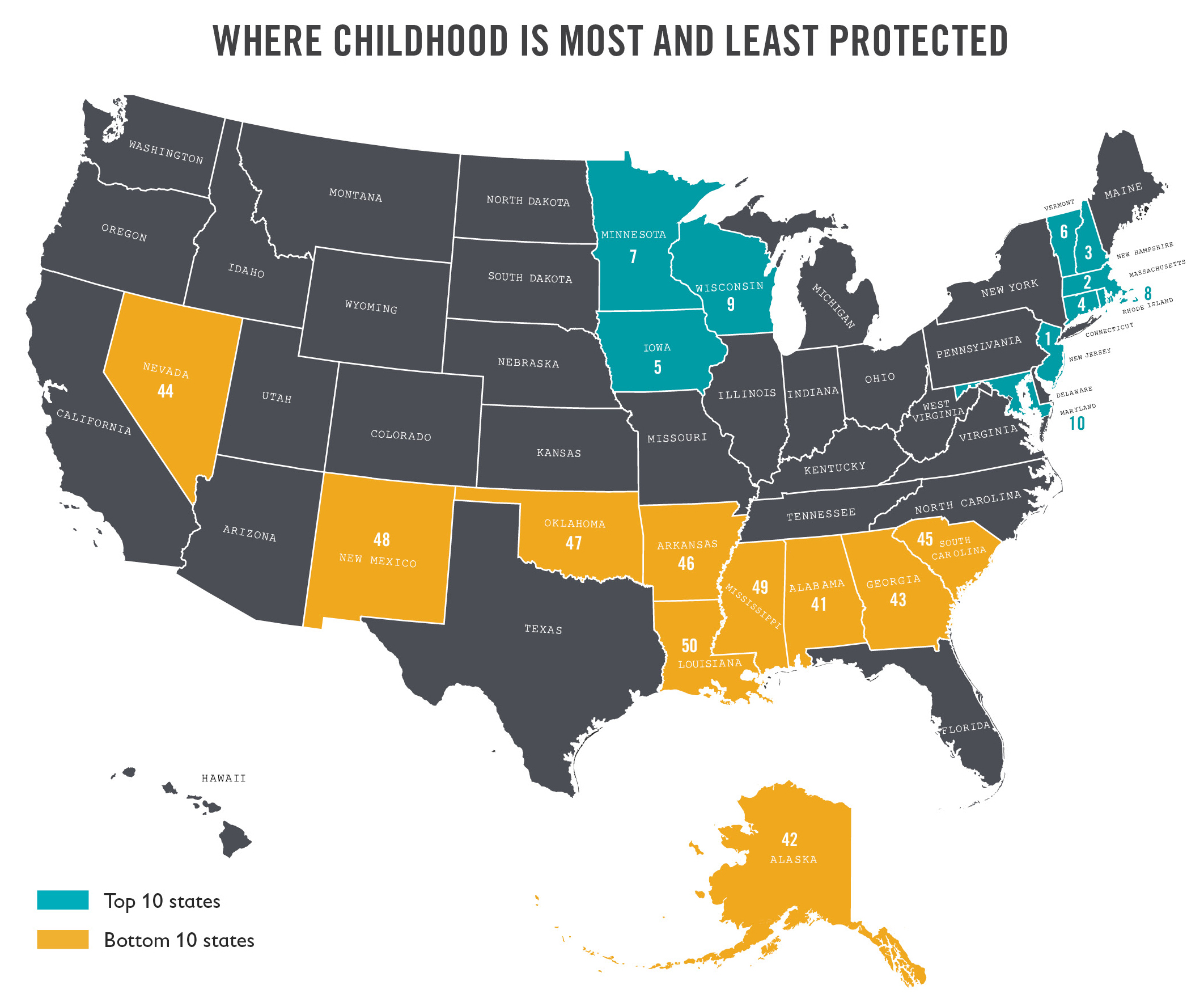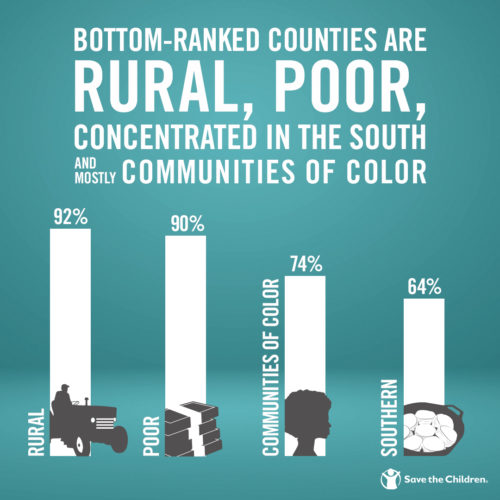When Shaquinda Burks came down with flu-like symptoms in mid-May, she braced for the worst. A 29-year-old single mother of two, she works in a nursing home in Oak Grove, La., a 20-minute drive from her home in rural Lake Providence. After several days of fever, aches, and chills, she tested positive for Covid-19; several days later, her 7-year-old daughter tested positive, too.
Before the pandemic struck, Burks was finding it difficult to make ends meet but prioritized putting food on the table. With Supplemental Nutrition Assistance Program (SNAP) benefits, free breakfast and lunch for her daughter at school—78 percent of Louisiana children qualify for subsidized meals—and help from family members, there was usually enough to eat. But suddenly, Burks was out of work and home sick with her daughter and 2-year-old son. At first, her daughter’s school offered a grab-and-go program, allowing low-income students to pick up meals during the week, but it was closed after just one week.
Families in Lake Providence, a town in Louisiana’s impoverished East Carroll Parish, know hardship and hunger. According to new county-level data on childhood inequality released today by Save the Children, some 40 percent of children in the parish are food insecure—the highest rate in the nation, comparable to rates in Bangladesh and Peru. The pandemic could pull East Carroll’s childhood hunger rate up to 53 percent, according to projections by Feeding America, a nationwide network of more than 200 food banks.
The pandemic has sent child hunger soaring to unprecedented rates. The national rate of food insecurity tripled between March and April; a May study from the Brookings Institution revealed that one-fifth of mothers were struggling to feed their kids—the highest rate since such data became available in 2001. Research from the Urban Institute shows that the situation is far more dire for black and Latinx families.
Hunger among families in East Carroll Parish and elsewhere across the country is not just the consequence of a deepening economic crisis or a strained supply chain. At its core, food insecurity stems from a weak social safety net that the largely nonprofit anti-hunger system is ill equipped to replace.
Popular
"swipe left below to view more authors"Swipe →Save the Children’s report paints a grim picture of childhood in the United States, which trails almost all Western European countries in the organization’s 2020 rankings. In rural America, where resources are already sparse, the impact is particularly acute. Children face more hardships in rural settings than in cities, the data finds, and two-thirds of the lowest-ranked counties are in the South. Ninety percent of US counties with high rates of childhood hunger are rural—communities that are emerging as the next hot spots for Covid-19. And while just 12 percent of US counties are majority nonwhite, they make up 74 percent of the report’s bottom-ranked counties.
“In these rural parishes, there aren’t large chain grocery stores, and shopping is difficult, especially when it comes to fresh products,” said Jean Toth, the executive director of the Food Bank of Northeast Louisiana, which serves East Carroll Parish. Food banks are typically based in bigger cities—hers is in Monroe, over an hour from Lake Providence—and local partners have had trouble filling the gap.
The first congressional pandemic relief package, passed in March, allowed some families to get additional SNAP benefits and created an emergency program, Pandemic Electronic Benefit Transfer (P-EBT), that added the value of school meals to grocery vouchers. But with checkered rollouts and eligibility restrictions, anti-hunger advocates say these mechanisms have failed to meet rising need.
Burks qualified for emergency SNAP benefits, receiving an additional $192 a month. But with record-high food prices, that goes only so far. “I’m grateful for the extra SNAP money, but it’s not enough when food is so expensive, when I’m not working, and when I have two kids to feed,” she said. By the end of the month, her daughter ends up “doing more snacking than anything else, mostly microwave dinners or Hot Pockets, not full, home-cooked meals.” Burks has yet to receive unemployment insurance benefits.
In normal times, school meals are critical in helping low-income kids get enough to eat, according to Lauren Bauer, a fellow at the Brookings Institution. Since the pandemic forced schools shut, “what’s stood up in place of the program hasn’t reached all eligible families, creating a huge burden to provide three meals a day when kids are at home,” she said.
 In 45 states, grab-and-go school meals were disrupted or stopped operating, and many parents were concerned about infection. “If you think you’ll endanger your family by getting the disease when you pick up food, you’re not going to pick up food,” Bauer said. “If you’re an essential worker—disproportionately women of color—you can’t pick up these meals, and the best way to feed your family is to keep your job.”
In 45 states, grab-and-go school meals were disrupted or stopped operating, and many parents were concerned about infection. “If you think you’ll endanger your family by getting the disease when you pick up food, you’re not going to pick up food,” Bauer said. “If you’re an essential worker—disproportionately women of color—you can’t pick up these meals, and the best way to feed your family is to keep your job.”
An uneven start to the program left many families behind. By May 15—two months after its passage—only 15 percent of eligible children had received P-EBT benefits nationally, according to The New York Times.
The launch was particularly slow in Southern states. In Louisiana, where 600,000 children qualify for the program, privacy laws complicated school districts’ ability to share student information with the Department of Children and Families. And although eligible families will receive missed benefits retroactively, Bauer said “that doesn’t solve the fact that for months after the pandemic bill, they were going without them.”
Some families haven’t even been able to apply, said Danny Mintz, an anti-hunger advocate at the Louisiana Budget Project. Many in the state don’t have access to a computer or stable Internet access, and the application isn’t mobile-friendly. P-EBT, he added, “could have served as a lifeline for immigrant families”—low-income children receive free school lunch regardless of immigration status, making the benefit one of few undocumented families can access—but the online application was available only in English. “Our concern is that the state may have already gotten the lowest-hanging fruit but that the people who are most in need are likely having trouble getting a benefit that’s owed to them.”
Burks is still waiting on P-EBT, and while she’s been able to get by with emergency SNAP dollars, that hasn’t been the case for the neediest families. That’s because under the US Department of Agriculture’s interpretation of the provision, households already receiving maximum monthly SNAP assistance are ineligible for the extra allotment. “That’s 40 percent of SNAP households and 5 million kids,” Bauer said. “Five million kids in the most disadvantaged households who received no additional SNAP money, didn’t get P-EBT—at least not yet—and haven’t been able to get grab-and-go meals. It’s not surprising that we’re seeing massive food insecurity.” (In California a class action lawsuit is challenging the USDA’s interpretation in order to expand the allotment to all families.)
As has been the case with unemployment benefits, states have been unable to absorb the spike in demand for SNAP. “Applications increased dramatically in early April, and that totally overwhelmed Louisiana’s ability to process them quickly,” Mintz said, citing a backlog of over 90,000 applications.
Lockdown measures and recent price hikes have also affected emergency providers and emboldened advocates’ demands for more federal assistance to families. “There’s a big drop in the amount of food donated across our entire network, so food banks are looking to purchase more items, which greatly increases our operating costs,” said Toth. The supply chain, she added, is bottlenecked, with delivery times estimated at eight weeks.
In mid-May, the Trump administration launched a $3 billion food relief program, giving contracts to distributors to provide fresh produce to food banks. But reporting by ProPublica revealed that many of those contracts were awarded to companies that had no experience in food distribution, from wedding caterers to brand builders; distribution has been beset by delays.
“The biggest concern is getting to a place where there’s more food in the pipeline, just in terms of having an inventory of shelf-stable food,” said Korey Patty, the executive director of Feeding Louisiana. “There are purchase opportunities, but prices are through the roof, and we’re running to find resources, especially as we move toward hurricane season. We usually talk about food banks being the last line of defense.”
Experts on food insecurity say that federal assistance tools like SNAP—not food banks—should be at the forefront of anti-hunger efforts. For every meal a food bank provides, SNAP provides nine. Food stamps are particularly important in rural America, where it’s harder for residents to get to food banks. Households in small, rural towns use federal food aid at particularly high rates.
But SNAP is largely excluded from the Trump administration’s recent Coronavirus Food Assistance Program, and Republicans have consistently rejected Democrats’ calls for a 15 percent increase across the program, rather than the short-term emergency increase that has helped only some needy families. Food banks, too, have urged Congress to expand SNAP, including to undocumented immigrants.
“What’s supplied by food banks does not meet people’s nutritional needs,” said Kathleen J. Fitzgerald, an assistant professor of sociology at the University of North Carolina, Chapel Hill, especially as demand rises and donations drop. She stressed that food insecurity is a social phenomenon rather than “the result of inadequate production,” noting, for example, that Louisiana produces more than 850 million pounds of seafood each year.
“The bottom line is this: Simply leaving it up to the market to address food insecurity and hunger is not working,” she said. “We need more robust government programs at the federal level and creative solutions at the state level to address these problems.”
Sometimes, the problem isn’t only about getting enough to eat; it’s about getting healthy, nutritious food. For one Louisiana mother I spoke to, who preferred to remain anonymous, food banks have been essential to caring for her 19-year-old special-needs son. Although she received additional SNAP benefits, the pandemic forced her to leave her part-time jobs—filling in as a substitute teacher and cleaning homes—and she’s afraid to take her son to the grocery store. She relies primarily on frozen meats and nonperishable goods that a nearby church distributes. “It’s lots of crackers, canned foods, no fruits and vegetables, nothing like that,” she said.
Anti-hunger advocates say that mounting food insecurity is a poignant reminder of the social determinism of health in America—especially as Covid-19 kills people with preexisting conditions that partly stem from poor nutrition.
“It’s a question of resources, especially as it relates to diet and nutrition, and rates of chronic health conditions, of diabetes and obesity,” Patty said. “When there’s more available, you’re able to get fresh produce and vegetables.”
Burks is crossing her fingers that her P-EBT will get processed soon. But she’s afraid that when her emergency SNAP benefits run out, she won’t be able to get by, especially if she can’t go back to work and schools stay closed. “I’m worried that things will become tremendously tough,” she said. “I don’t want to see my kids go hungry.”



